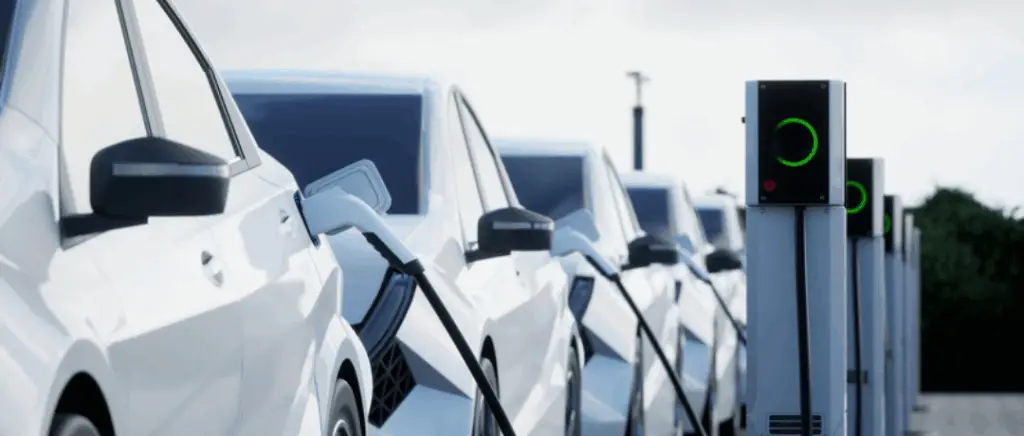Why have charging stations become a must for businesses in 2025?
In the past, the provision of company charging points was perceived as a simple value-added service, the icing on the cake to attract electromobilists. Today, the situation has changed: these infrastructures represent a real lever for growth, which can be activated at different levels to generate direct and indirect benefits.
Anticipating legal obligations
Installing recharging points is a must for all companies with a vehicle fleet. vehicle fleet. The legislative context is in line with this. For several years now, the LOM (Mobility Orientation Law) imposes a quota of electric vehicles or rechargeable hybrids in the renewal of the vehicle fleet. company fleets with more than 100 vehicles. This quota is set to increase gradually over the coming years.
| Deadlines | Quotas for clean vehicles (100 % electric, hydrogen or rechargeable hybrid vehicles) |
|---|---|
| From 1 January 2022 | 10 % renewal |
| From 1 January 2024 | 20 % renewal |
| From 1 January 2027 | 40 % renewal |
| From 1 January 2030 | 70 % renewal |
Regulatory quotas for renewing fleets with clean vehicles (fleets of more than 100 vehicles)
It is therefore up to the companies concerned to equip themselves with recharging infrastructures in order to ensure the smooth operation of their vehicles.autonomy and the availability of their vehicles on site.
Meeting your employees' expectations
According to the barometer published by Avereat the end of December 2024, 1.3 million 100 % electric vehicles were part of the French fleet. This trend is accelerating, as the European directive of 19 April 2023 provides for a ban on the sale of new combustion-powered vehicles. from 2035This is despite the fact that French MPs have refused to enshrine this date in national law.
So even if you don't own a fleet of cars, your employees naturally expect to be able to recharge their vehicles at work. Installing charging stations is much more than an optional service: it's essential if your company is to remain attractive to its employees.
What legal obligations will apply to the installation of charging points in businesses in 2025?
As of January 1, 2025, under the LOM law, the car parks with more than 20 spaces must have at least one recharging point, with one additional point for every 20 spaces. At least one charging point must be accessible to people with reduced mobility (PRM).
New buildings or those undergoing major renovation must also be pre-equipped, i.e. have conduits, sufficient electrical power and safety devices to facilitate the subsequent installation of the charging points.
The obligations under the LOM also apply to non-residential buildings, with varying conditions of application that take into account the size of the car park, the date on which planning permission was granted and the complexity of the work involved.
| Date of application for planning permission | Car park capacity | Pre-equipment required | Charging stations installed from 1 January 2025 |
|---|---|---|---|
| After 11 March 2021 | Parking > 10 spaces | 20 % | 1 charge point per 20 spaces (including 1 PMR) |
| Between 1 January 2017 and 11 March 2021 | ≤ 40 places | 10 % | |
| > 40 seats | 20 % | ||
| Between 1 January 2012 and 1 January 2017 | All car parks | 10 % | |
| Before 1 January 2012 | Car park > 20 spaces & urban area > 50,000 inhabitants | 10 % | |
| Car park > 40 spaces & urban area < 50,000 inhabitants | 5 % |
Obligations to pre-equip and install charging points in businesses by 2025
In addition to the legal requirements, the LOM lays down a number of technical constraints concerning the installation of IRVE (Infrastructures de Recharge pour Véhicules Électriques) :
- minimum power of 7 kW (recommended) ;
- Type 2 connectors compatible with the majority of electric vehicles in accordance with standard EN 62196-2 ;
- compliance with safety standard IEC 61851-1.
Good to know: certain companies may be exempt from these obligations if adapting their electrical installation requires work deemed to be major, for example modifying the Low Voltage Switchboard (article L111-3-5 of the Code de la Construction et de l'Habitation).

What benefits do charging stations offer employees and customers?
Easier mobility for your employees
Are you looking for an effective solution to improve the well-being of your employees and build loyalty? Installing a table football table in the break room and offering them croissants every Friday is a good start. But if you want to offer them a service that will really change their lives, make charging points available to them!
Your employees will be able to come to work without having to worry about their vehicle's range. Every day, they'll save time by avoiding the tedious search for a public charging point. And, above all, you'll be encouraging them to come back to the office and reinvest in your premises at a time when face-to-face work is looking bleak.
According to a survey conducted byYouGov, 56 % drivers of electric or plug-in hybrid cars would like to be able to recharge their vehicle at work.
Enhancing the customer experience
The presence of charging points in your car park contributes to the quality of your welcome for customers and visitors, who will certainly appreciate this service. As well as being practical, these facilities reflect your commitment to sustainable development and enhance your image. They are a real competitive advantage by demonstrating that you can anticipate your customers' needs while proactively supporting electric mobility.
How do charging stations reinforce CSR strategy and brand image?
Cultivating a virtuous image, far from greenwashing
At a time when legislation is forcing companies to be increasingly transparent about their environmental impact, they need more than ever to justify the actions they are taking to promote sustainable development. Installing recharging points is a practical, measurable way of reducing your environmental footprint. carbon footprint.
From 1 January 2024, the CSDR directive (Corporate Sustainability Reporting Directive), requires listed SMEs and large European companies to report annually on their CO2 emissions.
The installation of electrical bollards can become one of the pillars of your CSR strategy (Corporate Social Responsibility), mainly for two reasons:
- On the one hand, it's an approach that recognises your organisation's efforts in the field of sustainable development.
- secondly, connected charging stations give you access to concrete data to feed into your sustainability reports.
Strengthen your employer brand
Just as your investors, suppliers and customers expect tangible proof of your environmental commitment, so too do the talented people likely to join your teams. By installing charging stations, your company can position itself as a recognised player in the energy transition.

What financial assistance is available in 2025?
Led by Avere-France and supported by the French government, the Advenir programme has been supporting the roll-out of charging points in France for several years. Since 2023, the Advenir grant has become more selective. Aid for "traditional" private fleets is now very limited, and mainly concerns specific cases, such as heavy goods vehicles or charging points accessible to the public.
On the other hand car service and short-term vehicle rental professionals benefit from a enhanced assistance programme. Here is a summary of premiums in 2025 :
Automotive service professionals :
- Fleets and employees bonus 25 %capped at 750 EXCLUDING VAT per recharging point.
- Private car parks open to the public bonus 50 %with a ceiling of between 1,700 and €7,500 excluding VAT per charging point, depending on the power installed.
Short-term vehicle rental companies :
- Fleets and employees bonus 35 %with a ceiling of between 1,200 and €5,300 excluding VAT per recharging point.
- Charging points open to the public for independent service stations grant of 50 %with a ceiling of between 1,700 and €25,000 excluding VAT per recharging point.
Would you like to know if your company is eligible for the Advenir scheme? Test your eligibility now.
At the same time, you can also turn to the local grants offered by your region. One example is the Flexitanie programme in Occitanieor themobility aid from the Normandy Region. Don't hesitate to contact local authority representatives, as access arrangements change regularly.
Finally, there are tax benefits (tax credits, reduced VAT) and depreciation options that reduce the net cost of acquiring and deploying charging infrastructure.
How do you calculate cost and return on investment?
To estimate the profitability of a charging point installation project, you need to take into account the purchase price, not forgetting the costs associated with deploying and commissioning the infrastructure. The overall cost can vary according to a number of criteria:
- the power level chosen (between 7.4 kWh and 22 kWh), with prices ranging from €1,500 excluding VAT to €3,500 excluding VAT, including installation;
- any electrical work to be carried out (compliance with standards, remote connection of the electrical panel) ;
- integrated management and supervision systems.
To calculate the ROI on your recharging equipmentIf you're looking at the total cost of ownership, you need to put all these costs into perspective, along with the savings made. More and more fleet managers are taking the TCO (Total Cost of Ownership) into account to optimise the performance of a company fleet.
Electric or rechargeable hybrid vehicles help to reduce TCO on three levels: lower fuel costs, reduced maintenance costs and tax relief.
Potential income from charging users for top-ups must also be taken into account.
In this context, the return on investment can be achieved in just a few years.For example, if the initial investment in a charging point, including both acquisition and maintenance costs, is 2,500 euros, and if the savings, plus the income generated annually, are around 500 euros, your installation will pay for itself in just 5 years.
What technical solutions should you choose?
Before choosing a charging point model, start by asking yourself the right questions.
- What is the size of your fleet and how many electric or hybrid vehicles does it include?
- What types of users (employees, travelling sales staff, customers, visitors)?
- What is the estimated frequency of use (one-off, daily)?
- What is the vehicle turnover rate (variable according to the number of journeys made by your employees in the course of a working day)?
This initial analysis, which you can then expand on with a detailed specification, will give you an idea of the type of terminal best suited to your project and the power required.
Generally speaking, to recharge commercial vehicles or light commercial vehicles used for multiple daily journeys, it makes more sense to opt for fast to ultra-fast charging stations (22 kW or more).
If your employees' vehicles are parked for several hours without being used, 7.4 kW to 22 kW charging points will be sufficient to cover their needs. Ultra-fast direct current (DC) charging points are much more expensive, and should be reserved for fleets that are used intensively, or if you plan to open your facilities to the public by monetising charging.
Our advice: Before taking the plunge, think about the changes linked to the regulatory context and the greening of the French car fleet. Prevention is better than cure: it's wiser to plan for a future-proof infrastructure, where you can integrate new equipment more easily, rather than having to undertake new work at a later date.
Monday to Friday
9am to 12.30pm and 2pm to 7pm
How can it be integrated into fleet management?
Do you think that a charging point just power your professional electric or rechargeable hybrid vehicles? You'll be surprised to discover the potential of this equipment as a control tool. Whether you supervise your vehicle fleet or you're relying on the skills of a fleet manager, installing intelligent charging points will give you access to undreamt-of functionalities.
The principle: the data collected during recharging enables consumption to be tracked down to the nearest kWh, as well as providing forecasts and indications for organising the schedules of your sales staff, optimising rounds, anticipating maintenance operations and reducing operating costs.
What does the future hold for renewable energies and smart charging?
In recent years, the smart charging is on everyone's lips. Presented as the future of charging stations, it is based on a skilful combination of increasingly sophisticated control technologies and rationalised energy consumption.
Are you curious about how intelligent charging stations ? In simple terms, these charging points are capable of adjusting charging by distributing it between the different vehicles according to the constraints of the electricity network. This modulation prevents overcharging and encourages consumption during off-peak hours.
For optimum cost reduction, smart charging can be combined with renewable energies. For example, by installing solar panels on your carports or photovoltaic shadingYou can autonomously produce the electricity you need to power your fleet of electric vehicles.
In 2025, install charging stations is a strategic decision for companies, whatever their size or sector of activity. While the regulatory obligations designed to speed up the energy transition seem to increase the number of constraints, particularly in terms of time and finance, any project to roll out charging infrastructure can also be seen as an opportunity.
At Beev, our aim is simple: to help you get the most out of your charging infrastructure. You can count on our enthusiastic and passionate team every step of the way. Whether you need to anticipate your legal obligations, select the most appropriate charging points, rationalise your costs or choose a management solution, there's bound to be a tailor-made solution to suit your budget and your business challenges.
Because we're convinced that the future of mobility is electric. And it starts today, in your company!
































